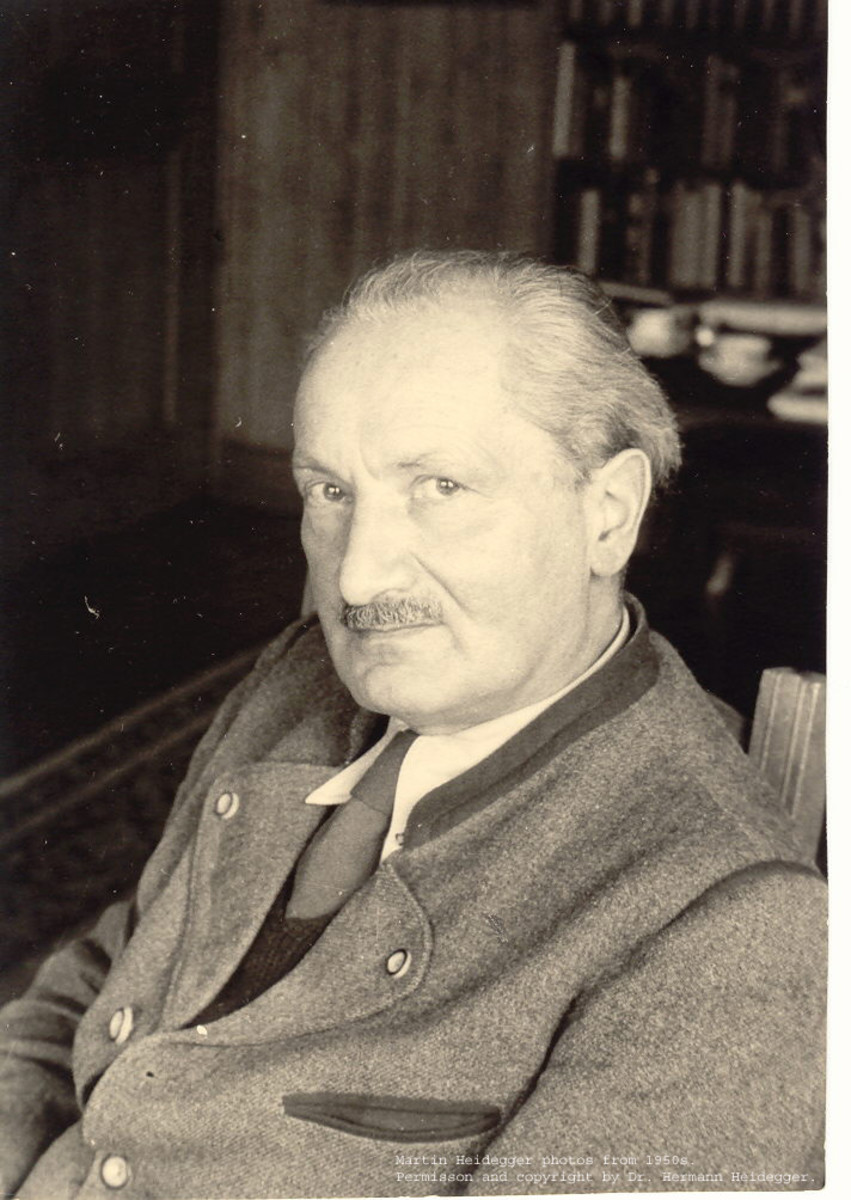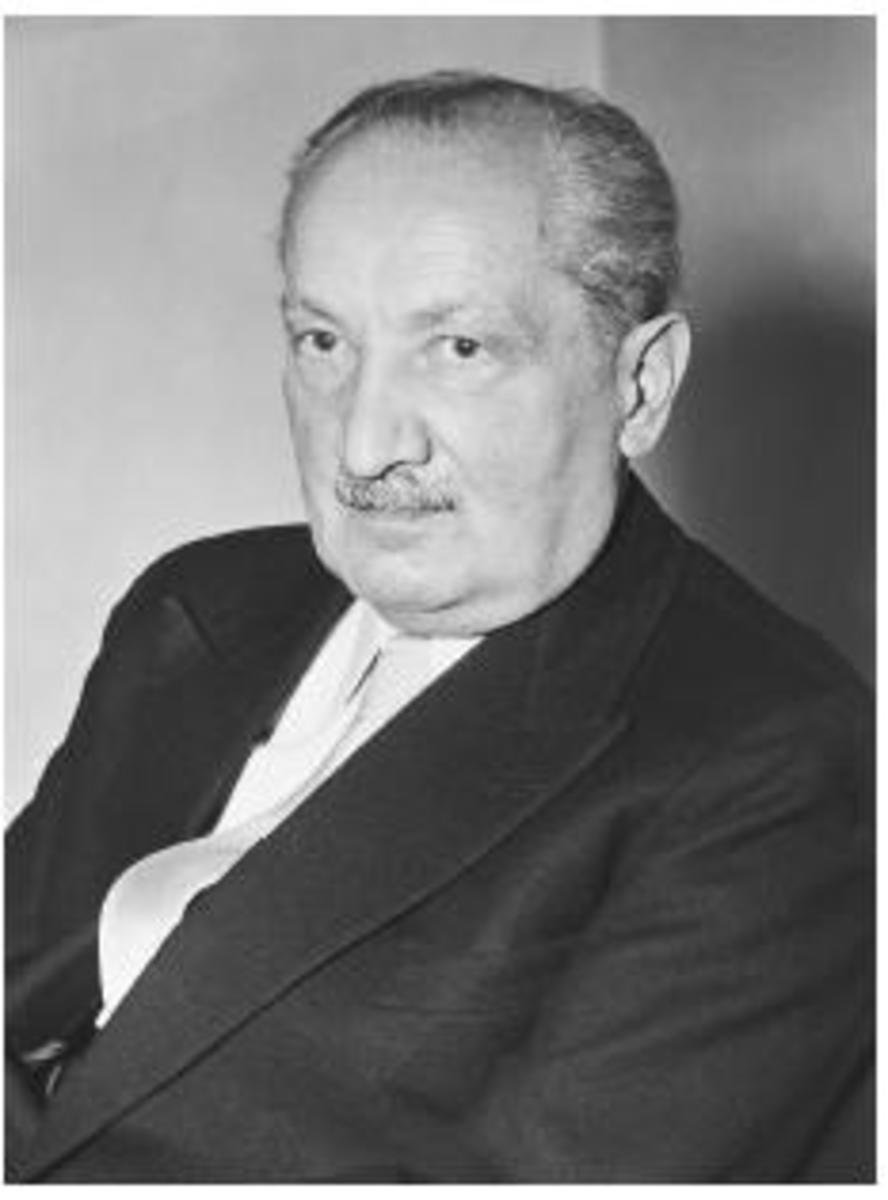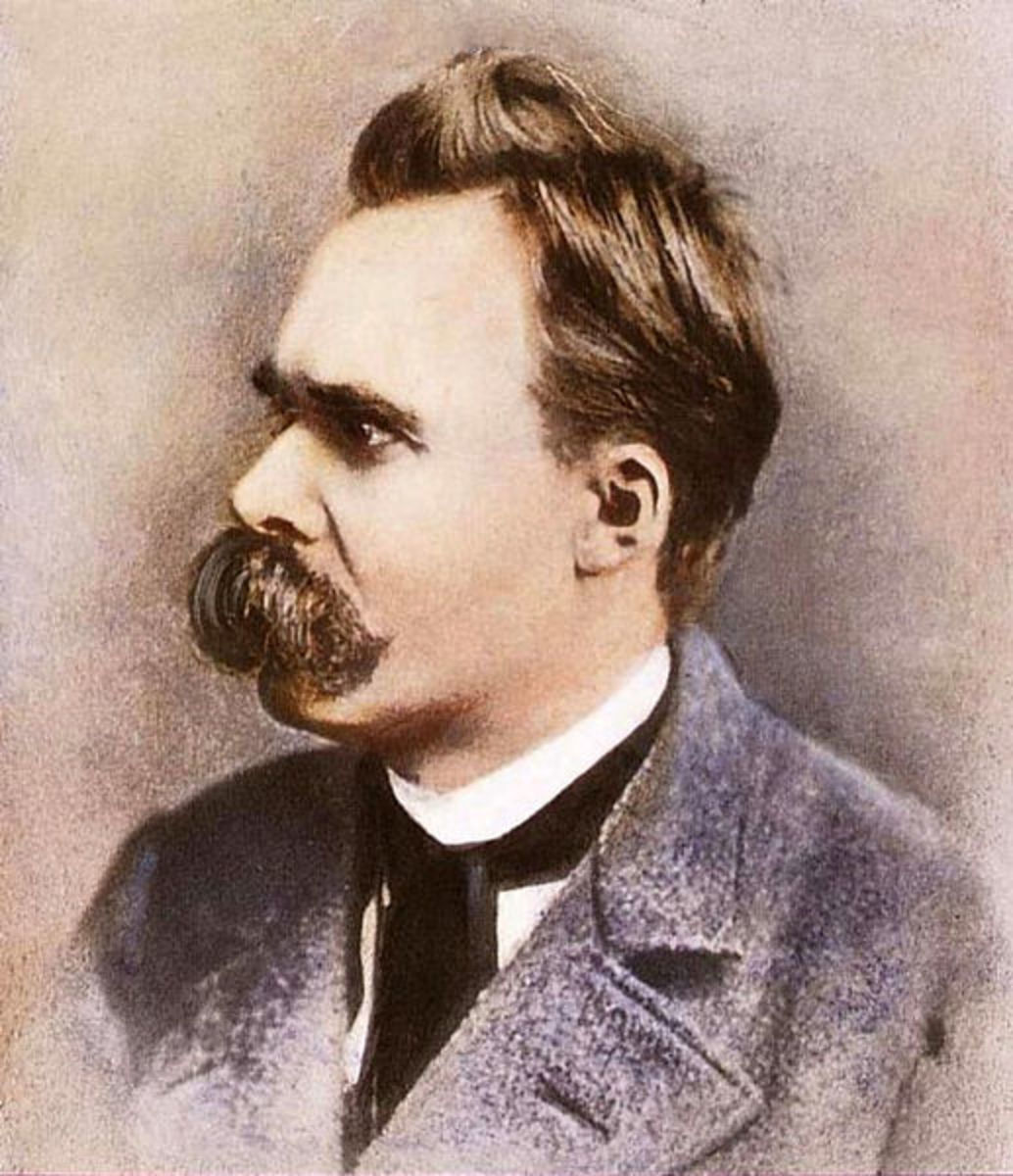Understanding Heidegger
The existentialist writings of Martin Heidegger are difficult not only because of the subject matter, but also because of the use of many uncommon terms and odd word combinations. Through the use of such unusual language, a reader can easily misinterpret the meaning Heidegger intends these terms to convey. Here, I hope to explore certain key terms found in Heidegger’s Being and Time, in order to fully flesh out their significance. I want to focus particularly on the concepts of, ‘The-they,’ ‘authenticity/inauthenticity,’ and ‘fallenness.’ I have chosen these specific terms because they express important themes in existentialist philosophy. I feel that an effective way of illustrating the meaning of these terms is to make reference to the film Holiday.This film touches on several issues central to those I wish to discuss.
First, I want to briefly discuss Heidegger’s existentialist philosophy in general before I begin with a specific comparison to the film. In Being and Time, Heidegger’s aim is to get at the meaning of Being. That is, Heidegger wants to understand what a thing is in its most basic state, or what makes a thing the thing that it is. An important part of understanding Being is inquiring into the necessary structures that beings exist in. For example, human beings are defined by the world we live in, by the fact that we are aware of our Being, and that Being is an issue for us. Heidegger’s focus on the meaning of Being is centred on human beings; however, in theory, he does not limit his inquiry into the meaning of Being to human beings alone. In fact, Heidegger employs the term “Dasein” which is meant to capture a broad range of beings. Essentially Dasein is, “that for which being is an issue” (p. 32). Therefore, Dasein can be considered a widely encompassing term. However, here I want to focus my efforts exclusively on understanding certain aspects of the human being. The terms I concentrate on have to do with the different ways in which humans interact with the rest of society, and the ways in which they choose to live their lives. More specifically, the terms I will discuss, centre on the way in which people choose to orient themselves in relation to everyone else, the goals they set for their future, and the way they can lose sight of their nature and fall into averagenness.
In order to draw comparisons between Heidegger’s key terms and the film, it will first be necessary to give a brief synopsis of the film. In this film, Johnny Case (Cary Grant) plays a young man who has just returned from a holiday where he met a girl he has fallen in love with. The two plan to get married even though they have not gotten to know one another that well. It quickly becomes apparent that Johnny and his new fiancée, Julia Seton (Doris Nolan), are from two very different social backgrounds. We learn that Johnny has grown up quite poor and has had to work manual labour jobs to earn his way through college. Julia, on the other hand, has grown up in a very wealthy family, complete with a mansion, summer home, maids, and butlers. Despite the initial surprise of one another’s backgrounds, the two decide to approach Julia’s father, Edward Seton (Henry Kolker) for his blessing on the marriage. After some persuasion, Johnny and Julia convince Edward that they ought to be allowed to get married. The engagement is announced, and the wedding plans are made. However, as Johnny and Julia come to know one another more intimately, they discover that they each have a very different conception of what their future should look like. For instance, Johnny proclaims that he wants to make a little money – enough to travel for a while and be free, while Julia wants to continue living her comfortable lifestyle. Julia and her father both want to see that Johnny stays grounded by taking a position in the bank (owned by Edward Seton), but Johnny is reluctant to do so. Eventually, Johnny comes to the decision that he cannot submit to the life that Edward and Julia have mapped out for him; instead he cancels the engagement and plans to leave for Europe.
During the courtship between Johnny and Julia, Julia’s sister, Linda (Katharine Hepburn) has grown to be quite close to Johnny. In fact, it often appears as though Johnny and Linda have more in common than do Johnny and Julia. At the end of the film, Linda decides she and Johnny are much better suited for one another than he and her sister, and the two head off to Europe together to embark on a life of adventure.
Now with a general idea of the film, I can more deeply explore some of the common themes between the philosophy of Heidegger and this film. The first key term I want to discuss is ‘authenticity.’ I want to explore whether Johnny Case exemplifies Heidegger’s notion of living an authentic life. But before we can do this, I must first attempt to get clear on the notion of authenticity. Commonly, we think of authenticity as “the real thing.” For example, when we view a work of art, we ask whether this particular piece is authentic, or if it is a mere copy of the original. Thus, authenticity is often taken to mean “the real thing,” or, “an original.” So, when we attempt to apply the term authenticity to a human being, we are inclined to think that the authentic person is she who is an original, or is living a “real,” non-superficial life. However, this understanding of authenticity may not completely fit with Heidegger’s conception of the term.
Heidegger does not provide a concrete definition of what he means by ‘authenticity,’ though, he does say how to achieve authenticity. Heidegger claims that the only way to achieve authenticity is to live a life in pursuit of possibility, and that we pursue this through resoluteness (p. 344-345). However, Heidegger is careful to note that living a life of pure possibility is not what it means to be authentic, because authenticity does not involve one becoming a “free-floating “I”” (p. 344). Heidegger then goes on to imply that the authentic life is striking a balance between actuality and possibility (p. 344).
There are a lot of key concepts by Heidegger that need to be explained in greater detail. In order to understand what Heidegger means by these various terms that have just been introduced, I will proceed a bit more slowly. Central to existentialist philosophy is the notion that existence precedes essence. Hence, our essence is not determined before we are born, which is to say that we create our essence through our free choices. Thus, we ought not to be defined by what we might currently be, but rather, by what we may potentially become. As an existentialist, Heidegger reinforces this notion by saying that not only do we create ourselves through our actions, but it is a necessary part of our being that we define ourselves through possibility: “In determining itself as an entity, Dasein always does so in the light of a possibility which it is itself…”(p. 69). Heidegger later adds to this by saying, “Dasein is in every case what it can be, and in the way in which it is its possibility” (p. 183). In other words, possibility is an essential part of our Being; this is part of what it means to be human. Hence, when Heidegger says that authenticity lies in possibility, he means that we can break free from the actual circumstances of everydayness that we each find ourselves in, and live a more authentic life by confronting possibility. Actuality has to do with the actual circumstances we find ourselves in. Possibility has to do with our potential for becoming.
Now with regard to the film, we want to begin our enquiry of whether Case fits the description of Heidegger’s notion of authenticity, as it has been thus far outlined. First, we see that Case has been a labourer all his life and is not thrilled at the prospect of being confined to a desk job. He is being pressured into accepting a position at the bank, but he would rather go out into life and explore a little. Case proclaims that he wants to be free to live. He does not want to settle down. For Case, living a life of adventure and discovery is a more meaningful life than living life as a banker.
From this description we can see hints of some common points between the life of Johnny Case and Heidegger’s notion of authenticity. We see that Case wants to be free to explore, and does not want to settle into the life that will be expected of him when he gets married. Thus, it looks as though Case may be embarking on a life of authenticity due to the fact that he is confronting the situation he is faced with and is pursuing possibility. But before we commit ourselves to labelling Case as an authentic being, we need to delve more deeply into a few more issues raised by Heidegger.
I mentioned before about the everydayness that we find ourselves in. This everydayness has to do with the fact that we all exist in a society as individuals, yet –
to some extent at least – we are all fairly similar in that we generally tend to like the same things, share some common views and opinions on issues, behave the same way when in particular circumstances, and so on. Heidegger labels this everydayness as an ‘averagenness’ that we fall into. In our averagenness, we become accepting of authority figures and mainstream views; we become unreflective selves who are unable to think on our own. This averagenness is lived out by ‘the-they.’ ‘The they’ are the Others that we are all a part of and which we do not distinguish ourselves from. In our everyday lives, our individuality is absorbed into ‘the-they’ and this absorption is labelled as “fallenness.” The ‘they-self,’ which we become when we are like Others is contrasted with the authentic self, which we become when we confront possibility (p. 167). Hence, from this, we see that in order to be authentic, we need to separate ourselves, in some way, from Others.
In our absorption into ‘the-they,’ we have fallen, yet this fallenness is not seen as a way of descending. In fact, ‘the-they’ sees averagenness as a good thing, as a way of living the “right” kind of life, or “living concretely” (p. 223). We can see this point demonstrated quite well through the situation Case finds himself in at one point late in the movie. Here, Case questions whether he should give-in to the family’s wishes to become a businessman, or whether he should be free to create himself. Edward and Julia have represented a “desk job” as a way of ascending, but Case sees accepting a desk job as a way of “giving in” to averagenness – in other words, the life of inauthenticity. Case seriously begins to question whether the free life is the right choice to make. He notes that Ed and Julie seem so sure of themselves, that their course of action (i.e., the life of a business man) is the proper one: “Of course, they may be right. They seem so sure,” says Case.
The above example demonstrates, quite clearly, how each of us comes to be absorbed into the everyday averagenness of ‘the-they.’ We come to think that if we do what is expected of us, we will live the best life possible. However, when Case finally decides to forego the marriage and the desk job, it is here, I think, that he becomes authentic. Here, Case is confronting possibility. He is breaking free from this life plan that has been set out before him. Rather than fall into averagenness, he chooses the path of authenticity. He has separated himself from Others, and by doing so he has become authentic.
Linda Seton may also come to exemplify Heidegger’s notion of the authentic self. Throughout the film she appears to be the most authentic of the Seton children. Like Case, she too embarks on an adventure of confronting possibility. This alone, however, does not establish her as an authentic being. We must remember that authenticity is not about pursuing pure possibility. Heidegger is not advocating that one live a life of fantasy and adventure in order to become authentic.
In addition to this initial possible quality of authenticity, I think there are two more things that could establish Linda as an authentic self. The second reason Linda may be authentic is due to the fact that she thinks for herself and lives a lifestyle that is different than that of the rest of the Seton family. It is clear that she has chosen not to conform to her family’s expectations. We see this in her behaviour at the party, and by the fact that she does not seem to participate in family events, like attending church with the rest of the family, nor does she appear to be involved with working for the family business. This desire not to conform, I think, shows one more way that Linda is authentic.
The third reason I think Linda can be considered authentic has to do with Heidegger’s notion of ‘equipment’ and Linda’s special connection with the playroom. ‘Equipment’ describes a type of relationship we have with things that only forms by making use of, manipulating, and having concern for things. ‘Equipment’ is that which is closest to us (p 97). It describes a way of knowing things, or being familiar with things; it is a type of familiarity that one cannot get simply by seeing objects, one has to make use of, and become intimate with these objects. Linda has this type of close relationship with this room; there are many objects of concern here for her. The rest of the house is described as a museum, but the playroom is full of life and memories. The rest of the family do not see the room as anything special because they do not have the same attachment with it; they do not experience the room in the same way because they are not authentic selves. It seems to me that having a close relationship with things is a way to achieve authenticity.
While Heidegger does not explicitly say that having a close relationship with things leads to authenticity, I think he does hint at this. For example, he says, “[r]esoluteness brings the Self right into its current concernful Being-alongside what is ready-to-hand…” (p. 344). Now, ‘equipment’ makes up those objects that are ready-to-hand. And those objects that are ready-to-hand are those objects we meet with in concern. And in our resoluteness, we come closest to what is of concern and ready-to-hand. So, given that in resoluteness we are authentic, I would argue that having a close relationship with things that are of concern and ready-to-hand is another way to be authentic. Thus, in Linda’s close connection with the playroom, she is authentic.
Given our common understanding of authenticity – and even on a loose reading of Heidegger – one would think that in living an authentic life, one would be living a better life than those who are inauthentic. However, Heidegger makes it clear that, “…the inauthenticity of Dasein does not signify any ‘less’ Being or any ‘lower’ degree of Being. Rather it is the case that even in its fullest concretion Dasein can be characterized by inauthenticity…” (p. 68). Thus, it would seem that even though Johnny and Linda have both resisted the averagenness of ‘the-they,’ they are still not fully authentic. Nor, would it appear, can any person achieve pure authenticity.
I think Heidegger is getting at two different things here. The first is that even though we try to break free from averagenness and everydayness, our authenticity is still defined in terms of Others. When we claim to be authentic, we are only authentic relative to ‘the-they.’ In other words, those who think they are authentic believe so only because they are comparing themselves with another type of self (i.e., ‘they-self’) which is completely inauthentic. Therefore, we are never fully and completely authentic; we are only authentic, relatively speaking. The second point Heidegger is making is that authenticity and inauthenticity are both essential features of our Being, both define our Beingnness, and each belongs to us necessarily. Neither authenticity nor inauthenticity are features that are there by accident. We cannot escape this fact about our existence. The authentic self and the inauthentic self are simply two different ways of being. Each is a basic structure of our Being.
To offer one final observation, I would like to return to our previous discussion of ‘the-they.’ We can see another example of this concept at work in the film through the character of Edward Seton. I think Edward is representative of ‘the-they’ because he is always trying to stifle any creativity and adventure. We can see evidence of this when Edward notes that there is a spirit of revolt in the world that he doesn’t much like or understand. I think this spirit of revolt is a sign of confronting averagenness and received views about the world. Edward does not like this spirit because it opposes everything he believes in and values. We can see Edward imposing his mainstream beliefs and values onto other in several instances. For example, it becomes clear that Edward has thwarted his son’s efforts at becoming a fine musician. Instead of being allowed to pursue a career in music, Edward has forced Ned to live a more proper life, a life that is suited to someone in his social class. A job at the bank is a much more average and everyday kind of job, whereas being a musician presents all kinds of possibilities. Likely, Edward is concerned that there is too much uncertainty in pursuing a career in the Arts. Similarly, with regard to Case, Edward cannot fathom why a young man would rather pursue an unstable life of freedom and discovery than hold down a good-paying job at the bank. Edward cannot understand what is to be gained by pursuing a life so out of the ordinary and atypical. And finally, with regard to Linda, Edward is always trying to rein her in and mould her to the rest of the family. Edward would likely be most pleased if Linda would conform to his expectations. Edward’s belief in the fact that his views are the right views is so ingrained that he cannot understand why Linda behaves the way she does. All these qualities of Edward strike me as being qualities of ‘the-they.’
In closing, what I have attempted to do here is draw out the meaning of certain key terms in Heidegger’s writing. Hopefully the points raised in the film served to illuminate the meaning of these terms. Though Heidegger’s writings can be difficult to follow at times, there are many important themes being discussed. We have come to see that a life of authenticity is quite different than that of the common conception of the term. We have reviewed Heidegger’s notion of authenticity, and possibly shed light on a new way of understanding authenticity. Finally, we have gotten a sense of who ‘the-they’ is, and how the individual relates to them.
Bibliography
Martin Heidegger, Being and Time, translated by John Macquarrie and Edward Robinson (New York: Harper & Row, 1962).







